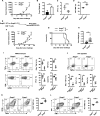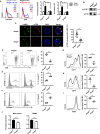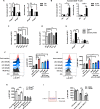Amino acids and RagD potentiate mTORC1 activation in CD8+ T cells to confer antitumor immunity
- PMID: 33883257
- PMCID: PMC8061841
- DOI: 10.1136/jitc-2020-002137
Amino acids and RagD potentiate mTORC1 activation in CD8+ T cells to confer antitumor immunity
Abstract
Background: In the tumor microenvironment, tumor cells are able to suppress antitumor immunity by competing for essential nutrients, including amino acids. However, whether amino acid depletion modulates the activity of CD8+ tumor-infiltrating lymphocytes (TILs) is unclear.
Method: In this study, we evaluated the roles of amino acids and the Rag complex in regulating mammalian target of rapamycin complex 1 (mTORC1) signaling in CD8+ TILs.
Results: We discovered that the Rag complex, particularly RagD, was crucial for CD8+ T-cell antitumor immunity. RagD expression was positively correlated with the antitumor response of CD8+ TILs in both murine syngeneic tumor xenografts and clinical human colon cancer samples. On RagD deficiency, CD8+ T cells were rendered more dysfunctional, as demonstrated by attenuation of mTORC1 signaling and reductions in proliferation and cytokine secretion. Amino acids maintained RagD-mediated mTORC1 translocation to the lysosome, thereby achieving maximal mTORC1 activity in CD8+ T cells. Moreover, the limited T-cell access to leucine (LEU), overshadowed by tumor cell amino acid consumption, led to impaired RagD-dependent mTORC1 activity. Finally, combined with antiprogrammed cell death protein 1 antibody, LEU supplementation improved T-cell immunity in MC38 tumor-bearing mice in vivo.
Conclusion: Our results revealed that robust signaling of amino acids by RagD and downstream mTORC1 signaling were crucial for T-cell receptor-initiated antitumor immunity. The characterization the role of RagD and LEU in nutrient mTORC1 signaling in TILs might suggest potential therapeutic strategies based on the manipulation of RagD and its upstream pathway.
Keywords: CD8-positive T-lymphocytes; lymphocyte activation; lymphocytes; metabolic networks and pathways; tumor microenvironment; tumor-infiltrating.
© Author(s) (or their employer(s)) 2021. Re-use permitted under CC BY. Published by BMJ.
Conflict of interest statement
Competing interests: None declared.
Figures






Similar articles
-
IL-36β Promotes CD8+ T Cell Activation and Antitumor Immune Responses by Activating mTORC1.Front Immunol. 2019 Aug 7;10:1803. doi: 10.3389/fimmu.2019.01803. eCollection 2019. Front Immunol. 2019. PMID: 31447838 Free PMC article.
-
Coordination of the leucine-sensing Rag GTPase cycle by leucyl-tRNA synthetase in the mTORC1 signaling pathway.Proc Natl Acad Sci U S A. 2018 Jun 5;115(23):E5279-E5288. doi: 10.1073/pnas.1801287115. Epub 2018 May 21. Proc Natl Acad Sci U S A. 2018. PMID: 29784813 Free PMC article.
-
DNGR-1 limits Flt3L-mediated antitumor immunity by restraining tumor-infiltrating type I conventional dendritic cells.J Immunother Cancer. 2021 May;9(5):e002054. doi: 10.1136/jitc-2020-002054. J Immunother Cancer. 2021. PMID: 33980589 Free PMC article.
-
Regulation of mTORC1 by the Rag GTPases.Biochem Soc Trans. 2023 Apr 26;51(2):655-664. doi: 10.1042/BST20210038. Biochem Soc Trans. 2023. PMID: 36929165 Free PMC article. Review.
-
Effector, Memory, and Dysfunctional CD8(+) T Cell Fates in the Antitumor Immune Response.J Immunol Res. 2016;2016:8941260. doi: 10.1155/2016/8941260. Epub 2016 May 22. J Immunol Res. 2016. PMID: 27314056 Free PMC article. Review.
Cited by
-
The Role of Tumor Metabolic Reprogramming in Tumor Immunity.Int J Mol Sci. 2023 Dec 13;24(24):17422. doi: 10.3390/ijms242417422. Int J Mol Sci. 2023. PMID: 38139250 Free PMC article. Review.
-
Analyzing the impact of metabolism on immune cells in tumor microenvironment to promote the development of immunotherapy.Front Immunol. 2024 Jan 8;14:1307228. doi: 10.3389/fimmu.2023.1307228. eCollection 2023. Front Immunol. 2024. PMID: 38264667 Free PMC article. Review.
-
A bivalent nanoparticle vaccine exhibits potent cross-protection against the variants of SARS-CoV-2.Cell Rep. 2022 Jan 18;38(3):110256. doi: 10.1016/j.celrep.2021.110256. Epub 2021 Dec 23. Cell Rep. 2022. PMID: 34990583 Free PMC article.
-
Research Progress on Improving the Efficiency of CDT by Exacerbating Tumor Acidification.Int J Nanomedicine. 2022 Jun 10;17:2611-2628. doi: 10.2147/IJN.S366187. eCollection 2022. Int J Nanomedicine. 2022. PMID: 35712639 Free PMC article. Review.
-
Enhanced pentose phosphate pathway activity promotes pancreatic ductal adenocarcinoma progression via activating YAP/MMP1 axis under chronic acidosis.Int J Biol Sci. 2022 Mar 6;18(6):2304-2316. doi: 10.7150/ijbs.69526. eCollection 2022. Int J Biol Sci. 2022. PMID: 35414794 Free PMC article.
References
Publication types
MeSH terms
Substances
LinkOut - more resources
Full Text Sources
Other Literature Sources
Medical
Molecular Biology Databases
Research Materials
